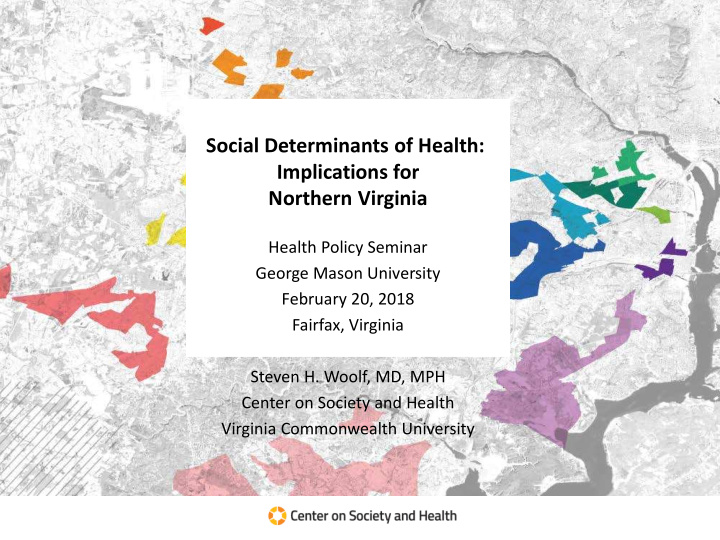



Social Determinants of Health: Implications for Northern Virginia Health Policy Seminar George Mason University February 20, 2018 Fairfax, Virginia Steven H. Woolf, MD, MPH Center on Society and Health Virginia Commonwealth University
Acknowledgments • Northern Virginia Health Foundation • Burness Communications • Coauthors: Derek A. Chapman, PhD Latoya Hill, MPH Lauren K. Snellings, MPH, CHES • Production: Sarah Blackburn and Cassandra Ellison
The good health of Northern Virginia COUNTY HEALTH RANKINGS, NORTHERN VIRGINIA 2012 2013 2014 2015 2016 2017 Arlington County 2 3 3 1 3 3 Fairfax County 1 1 2 3 2 2 Loudoun County 3 2 1 4 4 1 Prince William County 11 10 8 11 9 11
Life expectancy extremes in Northern Virginia: from 71 to 89 years
Health Systems Social and Medical Care Economic Factors Public Health Health Outcomes Physical and Individual Social Behaviors Mortality Environment and Morbidity Public Policies and Spending Source: Adapted from Woolf SH, Aron L, eds. U.S. Health in International Perspective: Shorter Lives, Poorer Health . Panel on Understanding Cross-National Health Differences Among High-Income Countries. National Research Council, Committee on Population, Division of Behavioral and Social Sciences and Education, and Board on Population Health and Public Health Practice, Institute of Medicine. Washington, DC: The National Academies Press, 2013.
Why the Differences?
Methods of analysis Census tract measures examined Analysis conducted by Center on • 1. Preschool (age 3-4 years) enrollment Society and Health, Virginia 2. Teens ages 15-17 years not enrolled in Commonwealth University school • 5-year data from the American 3. Population with high school or higher Community Survey, reported in 2013 education by U.S. Census Bureau 4. Population with Bachelor’s degree or • Conditions examined in 513 census higher tracts in Northern Virginia, including: 5. Households with limited English – Arlington County 6. Households with single parents – Fairfax County 7. Unemployment rate 8. Median household income – Loudoun County 9. Poverty rate – Prince William County 10. Child poverty – Cities: Alexandria, Fairfax City, 11. Public assistance Falls Church, Manassas, 12. Overcrowding Manassas Park 13. Uninsured rate
15 “islands of disadvantage”
Barriers to opportunity in Northern Virginia
The uneven demographic landscape in Northern Virginia
Examples of disadvantage Education Housing • • – 40% of adults with a high school – 79% of rental households with education (Bailey’s Crossroads, severe cost burdens (Prince 4516.01) William County, 9012.34) – 8% of adults with a Bachelor’s – Overcrowding in 29% of degree (Woodbridge, 9006) households (Bailey’s Crossroads, 4516.01) – 29% of households with limited English, Seven Corners (4514.00) • Health care Economic – 57% of adults uninsured (Bailey’s • Crossroads, 4516.01) – 27% of adults unemployed (Fort Myer, 1034.01) • Transportation – Median household income of – 36% without a vehicle $32,500 (Fort Myer, 1034.01) (Buckingham, 1020.03)
Printed reports
Interactive web tool Web tool available at website of the Northern Virginia Health Foundation: https://novahealthfdn.org/interactive-map-opportunity/
6715 Commerce Street, Springfield, VA Web tool available at website of the Northern Virginia Health Foundation: https://novahealthfdn.org/interactive-map-opportunity/
Taking action: policies to improve opportunity and population health • Solutions transcend the health sector • Benefits extend beyond the affected population – Strengthen regional economy – Improve academic performance – Increase workforce productivity – Reduce costs for health care and social services – Reduce criminal activity
Policy priorities • Basic needs • Infrastructure investments – Food – Physical environment – Housing – Built environment – Health care – Transportation • Root causes – Public safety – Education – Employment
Return on investment • Expanding opportunity requires larger investments in marginalized communities • Meaningful impact requires cross-sector collaboration • The benefits of partnership: attract employers, create jobs, energize the economy, grow infrastructure, engage the community—and improve public health
Contact Information Steven H. Woolf, MD, MPH Center on Society and Health Department of Family Medicine and Population Health Virginia Commonwealth University (804) 628-2462 swoolf@vcu.edu www.societyhealth.vcu.edu
Recommend
More recommend